
Extracellular matrix Health
Tissue protection keeps cells functioning
Extracellular matrix
The extracellular matrix (ECM) is a complex network composed of specific proteins (eg collagen, elastin, fibrillin), proteoglycans and glycoproteins. Components of the ECM are linked together to form a structurally stable structure, which contributes to the mechanical properties of tissues. The ECM is also a reservoir of growth factors and bioactive molecules. It is a highly dynamic entity of vital importance that determines and controls the most fundamental behaviors and characteristics of cells, such as proliferation, adhesion, migration, polarity, differentiation and apoptosis.
THE SYSTEM OF REGULATION THAT PENETRATES THE WHOLE BODY
Extracellular matrix
The functioning of the cells depends on the direct environment of the cell. This environment of the cells is formed by what we call the extracellular matrix (ECM). However, the ECM is more than just connective tissue, it is also made up of an extensive network of capillaries (called very fine blood vessels, capillaries), ends of nerves of the autonomic nervous system, and fluid.
The processes that take place in this matrix are referred to as matrix regulation, the largest regulatory system that permeates the entire body. The ECM regulation regulates the supply of nutrients to the cells as well as the removal of waste products from the cells. All immune processes take place there as well as processes related to tissue repair.
It is therefore responsible for all basic functions. Simply put, the extracellular matrix is involved in one way or another in every function and every process in a living body. Under the right conditions, the matrix will react very quickly and as a whole to stimuli. The ECM is connected via the capillary network to the hormonal system and via the peripheral nerves of the autonomic nervous system to the central nervous system. Since both regulatory systems are interconnected at the level of the brainstem, the higher regulatory centers may also be affected by the ECM.

THE EXTRACELLULAR MATRIX DETERMINES THE HEALTH OF CELLS
Alignment between cells and tissue
Communication between the extracellular matrix and the cells is the main task of this control system. This communication concerns the growth and stability of the cell itself. There is mounting evidence that the biochemical and biomechanical properties of the ECM influence the plasticity of cancer cells and vice versa. Mental aging and Alzheimer’s disease are also directly linked to a reduced ability to regenerate in the ECM of nerves.
Another example is the storage of non-bioavailable minerals such as Calcium, Magnesium or Copper, or toxic heavy metals in tissue cells. This also disrupts the functioning of cells in organs.
Keeping cells healthy is called ‘remodelling’. These remodeling processes are vital in the homeostasis of the body and allow normal cellular functions. When this process is disrupted, it leads to pathological processes and ultimately to various diseases. the expression of ECM-degrading proteases are very tightly controlled and regulated, when this balance is disturbed, inflammation and various degenerative processes arise.
The Hair Mineral Analysis is a system analysis that gives a general picture of the state of the ECM in the body. As such, it is an important part of a total system diagnosis because it reflects how and to what extent different disorders have permeated the body.



